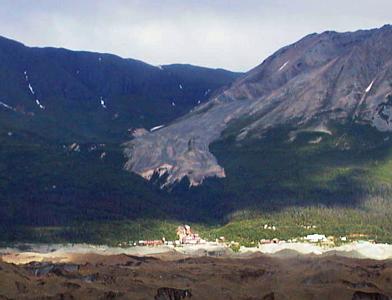
|
|
12 July, 2000
July 12, 2000
Surveyor Dennis Trabant has renamed Hidden Creek Lake. He now refers to it
as Lake Won't Be Gone. It is still on the rise, and hasn't slowed (2 feet
per day). We (PSU grad student Don Lindsay, PI Andrew Fountain, and myself)
drilled another hole today. We easily got to 235 meters before we hit
something relatively soft. It felt like some type of sediment at the bottom
of the hole. Based on Andrew Malm's (St. Olaf undergraduate) ice radar
results, we are uncertain about where the bottom of the glacier is located.
Yesterday he got a signal that corresponded to 1200 meters, which is very
deep. Today the weather was too wet for his equipment - a dense fog
descended on us for much of the day. Hopefully we will find out tomorrow how
thick the ice is at this location. In the meantime, we will soldier on and
start a third hole at this general vicinity tomorrow.
Drilling………………there is a reason why what is left is called a borehole.
Making one is a bore. Once the drill tip begins to melt its way through the
ice it descends at about 40 to 60 meters an hour. The person at the drill
usually keeps their hands around the descending hose, feeling for the banging
around of stones, or the occasional bounce of the drill tip on the bottom of
the hole. This person needs to make sure that the drill tip does not stop on
the bottom. So, throughout the course of 200 meters of drilling, this person
usually spends many hours sitting at the deepening borehole, feeling the
hose, making sure that it is still progressing downward. This is the
interesting job. A second person needs to keep an eye on the various
machines that make the drilling happen. Specifically, this person needs to
make sure that the pump that sends the water to the drill does not exceed a
certain pressure. This person sits and stares at a pressure gauge on the
pump for hours on end, and reports to the person at the drill if the pressure
is running too high. Drilling becomes interesting when the water level
changes in the borehole (this means that the borehole has made a connection
with an englacial conduit feature), or if there is a malfunction in the
equipment (then we get stand around and give our various opinions as to what
is wrong - Don Lindsay is usually right). This aspect of science is
ordinary. It has lots of tedious moments. It often encounters glitches.
Tenacity and creative solutions to unforeseen problems are the hallmark of a
successful field season. Analysis of data and development of theory are the
icing that comes only after long and arduous hours of hard, and at times
frustrating work.

The view to the north from the second drill site. The upper portion of the Kennicott glacier spills off the flanks of the Wrangell Mountains as a dramatic icefall. Note the two different colors of rocks surfacing the glacier (called moraine) that leads up the valley toward the icefall. In the left is moraine consisting of basalt, likely originating from the valley in the upper left of the photo. The gray rock is limestone, which consists of huge blocks. This rock spilled off of a different valley wall somewhere up-glacier. The line between the two different types of rocks represents the junction where two glaciers from different valleys flowed together into one large glacier.

The gray lobe extending down the side of the mountain is a rock glacier. The glacier originates in a cirque (a glacier-carved bowl in the side of mountain) high up on the mountain. It is called a rock glacier because it is comprised of a mixture of rocks (lots of them!) and ice.

Contact the TEA in the field at
.
If you cannot connect through your browser, copy the
TEA's e-mail address in the "To:" line of
your favorite e-mail package.
|
